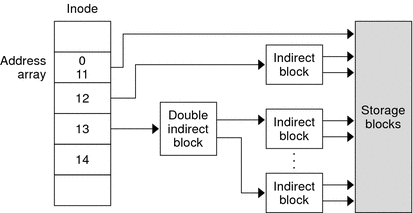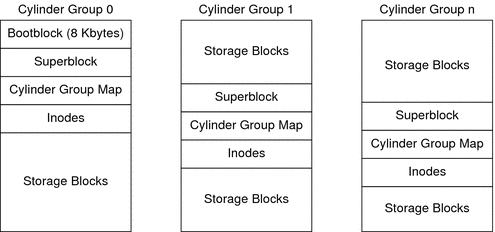| Previous | Next |
1. Managing Removable Media (Overview)
2. Managing Removable Media (Tasks)
3. Accessing Removable Media (Tasks)
4. Writing CDs and DVDs (Tasks)
5. Managing Devices (Overview/Tasks)
6. Dynamically Configuring Devices (Tasks)
7. Using USB Devices (Overview)
9. Using InfiniBand Devices (Overview/Tasks)
11. Administering Disks (Tasks)
12. SPARC: Adding a Disk (Tasks)
13. x86: Adding a Disk (Tasks)
14. Configuring Solaris iSCSI Targets and Initiators (Tasks)
15. Configuring and Managing the Solaris Internet Storage Name Service (iSNS)
16. The format Utility (Reference)
17. Managing File Systems (Overview)
18. Creating UFS, TMPFS, and LOFS File Systems (Tasks)
19. Mounting and Unmounting File Systems (Tasks)
20. Using The CacheFS File System (Tasks)
21. Configuring Additional Swap Space (Tasks)
22. Checking UFS File System Consistency (Tasks)
23. UFS File System (Reference)
Customizing UFS File System Parameters
24. Backing Up and Restoring File Systems (Overview)
25. Backing Up Files and File Systems (Tasks)
26. Using UFS Snapshots (Tasks)
27. Restoring Files and File Systems (Tasks)
28. UFS Backup and Restore Commands (Reference)
29. Copying UFS Files and File Systems (Tasks)
Structure of Cylinder Groups for UFS File Systems
When you create a UFS file system, the disk slice is divided into cylinder groups. A cylinder group is comprised of one or more consecutive disk cylinders. Cylinder groups are then further divided into addressable blocks to control and organize the structure of the files within the cylinder group. Each type of block has a specific function in the file system. A UFS file system has these four types of blocks.
Block Type |
Type of Information Stored |
|---|---|
Boot block |
Information used when the system is booted |
Superblock |
Detailed information about the file system |
Inode |
All information about a file |
Storage or data block |
Data for each file |
The following sections provide additional information about the organization and function of these blocks.
Boot Block
The boot block stores objects that are used in booting the system. If a file system is not to be used for booting, the boot block is left blank. The boot block appears only in the first cylinder group (cylinder group 0) and is the first 8 Kbytes in a slice.
Superblock
The superblock stores much of the information about the file system, which includes the following:
Size and status of the file system
Label, which includes the file system name and volume name
Size of the file system logical block
Date and time of the last update
Cylinder group size
Number of data blocks in a cylinder group
Summary data block
File system state
Path name of the last mount point
Because the superblock contains critical data, multiple superblocks are made when the file system is created.
A summary information block is kept within the superblock. The summary information block is not replicated, but is grouped with the primary superblock, usually in cylinder group 0. The summary block records changes that take place as the file system is used. In addition, the summary block lists the number of inodes, directories, fragments, and storage blocks within the file system.
Inodes
An inode contains all the information about a file except its name, which is kept in a directory. An inode is 128 bytes. The inode information is kept in the cylinder information block, and contains the following:
The type of the file:
Regular
Directory
Block special
Character special
FIFO, also known as named pipe
Symbolic link
Socket
Other inodes – Attribute directory and shadow (used for ACLs)
The mode of the file (the set of read-write-execute permissions)
The number of hard links to the file
The user ID of the owner of the file
The group ID to which the file belongs
The number of bytes in the file
An array of 15 disk-block addresses
The date and time the file was last accessed
The date and time the file was last modified
The date and time the inode was changed
The array of 15 disk-block addresses (0 to 14) points to the data blocks that store the contents of the file. The first 12 are direct addresses. That is, they point directly to the first 12 logical storage blocks of the file contents. If the file is larger than 12 logical blocks, the 13th address points to an indirect block, which contains direct-block addresses instead of file contents. The 14th address points to a double indirect block, which contains addresses of indirect blocks. The 15th address is for triple indirect addresses. The following figure shows this chaining of address blocks starting from the inode.
Figure 23-1 Address Chain for a UFS File System

Data Blocks
Data blocks, also called storage blocks, contain the rest of the space that is allocated to the file system. The size of these data blocks is determined when a file system is created. By default, data blocks are allocated in two sizes: an 8-Kbyte logical block size, and a 1-Kbyte fragment size.
For a regular file, the data blocks contain the contents of the file. For a directory, the data blocks contain entries that give the inode number and the file name of the files in the directory.
Free Blocks
Blocks that are not currently being used as inodes, as indirect address blocks, or as storage blocks are marked as free in the cylinder group map. This map also keeps track of fragments to prevent fragmentation from degrading disk performance.
To give you an idea of the structure of a typical UFS file system, the following figure shows a series of cylinder groups in a generic UFS file system.
Figure 23-2 A Typical UFS File System

| Previous | Next |